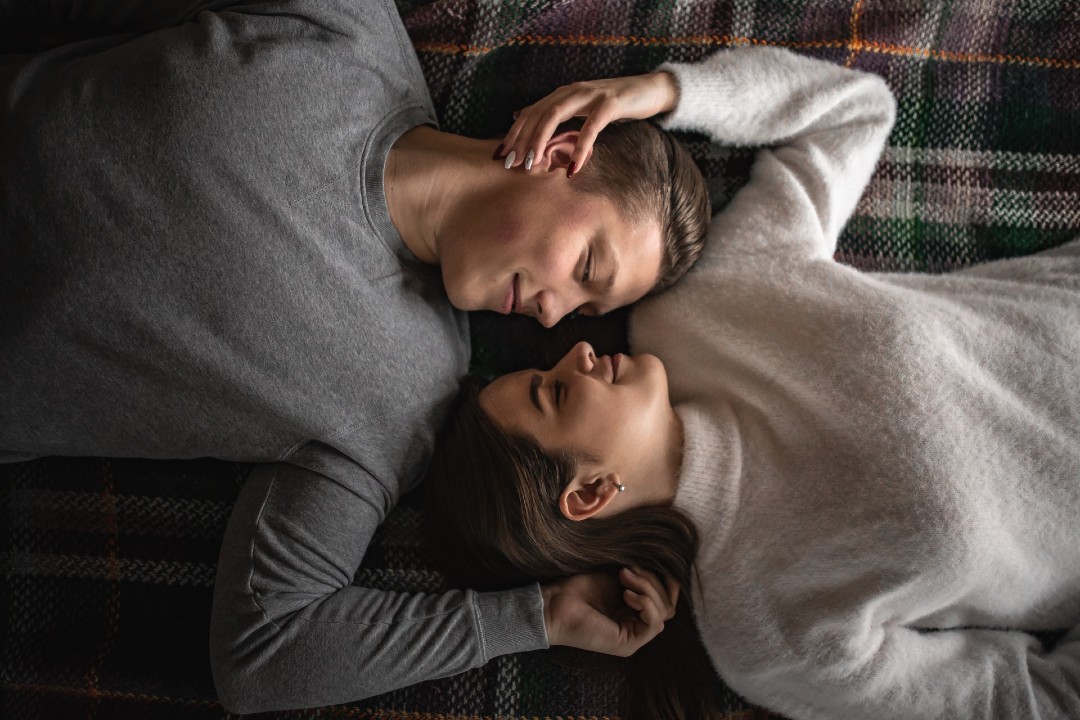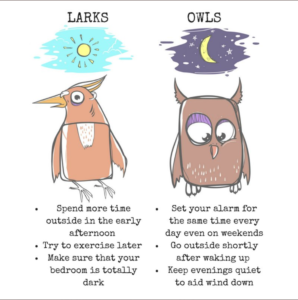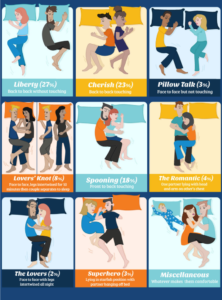We’re glued to social media, interested in how others are living. However, considering one-third of our lives is spent sleeping, shouldn’t we be a little curious about sleeping patterns and behaviors too?
The following article lays down the basis as to why men and women sleep differently. But, sleep is more personal than that — it goes beyond gender. Read about sleep chronotypes, the sleep positions of singles and couples, and why some women prefer to sleep with Fido above anyone or thing else.
Circadian Rhythm
People sleep differently because of natural circadian rhythms – physical, mental, and behavioral changes that respond to light in the environment. The rhythms of men and women differ. A man’s cycle is a bit longer (the average difference is about six minutes), which is why some associate men as “night owls” and women as “morning larks.”
Sleep gets even more personal — it’s actually biological. Sleep chronotypes seek to define specific sleeping patterns. Sleep specialists suggest knowing one’s chronotype helps synchronize daily activities around circadian rhythms.
Sleep Chronotypes
There are those who get up at 5am, exercise, eat breakfast, and address side projects before even getting to work for the day. Similarly, some have energy that lasts beyond the afternoon, well into the evening hours. These are behaviors of morning larks and night owls. While anyone can show characteristics of either group (by choice or necessity), we tend to feel our best when subscribing to one.
Identifying with a sleep chronotype helps regulate sleep/wake times and allows for greater awareness in planning the day. For example, the morning lark described above is not likely to get all those things done after work. Working against your natural wiring is possible but proves unproductive.
https://sleepypeople.com/
Personal Sleeping Positions
Don’t we all sleep in the same position? While you may have your own style of sleeping, others strike a variety of poses and sleeping positions.
- The ‘fetal’ position makes us feel as if we’re back in the womb, and most Americans sleep this way. However, more women report sleeping in the fetal (54% vs 39%).
- Those who sleep on their stomach adopt the ‘freefall’ position. Almost one in five sleepers do this despite 26% reporting it’s the worst sleeping position.
- The ‘yearning’ position pose looks like a person sleeping on their side with their hands out. 13% report sleeping this way, with a high percentage of Baby Boomers striking the pose.
- 11% of sleepers look like soldiers, keeping their hands to the side while sleeping on their back. Those in the ‘soldier’ position are unlikely to change position or toss and turn during sleep.
- Those in a ‘starfish’ position (like a soldier position but with arms turned upward at a 90-degree angle) pretty much stay in place throughout the night, yet only 7% report sleeping this way.
- Those who sleep like logs do so by positioning themselves on their side with arms down. While ‘sleeping like a log’ has positive connotations, only 6% report sleeping in this position.
Side sleeping, the most popular nighttime position listed above, can hint at more than just your preferred position when sleeping. It potentially points to an instinctive survival mechanism.
Many people with untreated sleep apnea prefer this position because it reduces compression of the airway and allows for more oxygen to get in. If you’re a side sleeper, especially one who snores, you may want to dig deeper to find out if your preference for side sleeping goes beyond comfort.
Furthermore, studies suggest sleep disorders have different influences on men and women. Females are more likely to report symptoms of insomnia — excessive daytime sleepiness, and difficulty with concentration and memory. Men often mention snoring, a symptom of sleep apnea.
Sleeping positions can be telltale signs of an underlying sleeping disorder. Side sleeping, for example, is associated with sleep apnea; that position reduces the chance of snoring and increases the flow of oxygen.
Couples Sleeping Positions
Things certainly get interesting when you share a bed with a partner. You’re sure to get a kick out of popular sleeping positions of couples.
- Liberty – This position ensures every citizen has their own independence throughout the night, as each person’s back is turned to the other, providing plenty of space. 27% of couples report sleeping this way.
- Cherish – This position is much like the preceding one but allows for back-to-back intimacy, as each partner scooches a bit closer so their backs are touching.
- Pillow Talk – While it’s sweet to face your partner while sleeping, as if you’re whispering sweet nothings even as you sleep, only 3% of couples report sleeping in this position.
- Lover’s Knot – The Lover’s Knot has good intentions, as couples fall asleep with legs intertwined, yet the knot comes undone as each sleeper eventually seeks individual positions.
www.dreams.co.uk/
- Spooning – Perhaps getting the most acclaim, the ‘spooning’ position is adopted by almost one in five couples, as one fetal-positioned sleeper, latches on or “spoons” the other.
- Romantic – Those in the romantic pose are comfortable enough for one to sleep on the other’s chest. It’s a bold sleeping move in the name of love, for only 4% of couples attempt it.
- The Lovers – This position combines Pillow Talk and Lover’s Knot. These couples get points for creativity yet it’s not very popular, being only 2% report sleeping this way.
- Superhero – While only 3% report doing so, it’s likely there are some unreported cases… The Superhero features one sleeper in a Starfish pose as their partner holds on for dear sleep, hanging halfway off the bed.
- Miscellaneous – This leaves whatever is left, for some not only sleep with partners, but deal with other visitors, such as children and pets.
Sleeping and Pets
One survey finds 45% of dog owners welcome their furry friends in their beds. Less stress, better emotional bond, and a greater sense of security are some offered reasons why it’s so easy to let pets sleep with us. However, one study found that 20% of those surveyed at a Sleep Clinic did mention pets disturb their sleep.
Maybe gender influences who is more likely to prefer sleeping with pets. One study shows women who cuddle-up with their dog report getting a better night’s sleep. Out of the 1,000 women surveyed, 55% shared a bed with (at least) one dog and just over 30% shared their bed with one cat or more. Women not only prefer sleeping with dogs than cats, but those surveyed, prefer a dog to a human partner when it comes to feelings of comfort and security.
Having Trouble Sleeping?
The worst sleeping pattern is one of deprivation and inconsistency. If you toss and turn to no avail, feeling no sleeping position allows for a great night’s rest, it may be indicative of an underlying sleep disorder, many of which go undiagnosed. A sleep study leads to proper diagnosis and updated treatments. Learn more about how Sleep Centers can get you sleeping and living better.
Citations:
American Academy of Sleep Medicine. “Sleep disorders affect men and women differently: Women are more likely to feel tired and depressed than men.” ScienceDaily. ScienceDaily, 23 May 2017. <www.sciencedaily.com/releases/2017/05/170523081838.htm>
Krahn, Lois E et al. “Are Pets in the Bedroom a Problem?.” Mayo Clinic proceedings vol. 90,12 (2015): 1663-5. doi:10.1016/j.mayocp.2015.08.012
<https://pubmed.ncbi.nlm.nih.gov/26478564/>
Hoffman, Christy L et al. “An Examination of Adult Women’s Sleep Quality and Sleep Routines in Relation to Pet Ownership and Bed Sharing.” Anthrozoos Journal. 13 Nov 2018.
<https://www.tandfonline.com/doi/citedby/10.1080/08927936.2018.1529354>
Lindberg, Sara. “Chronotypes, Sleep and Productivity.” Healthline. 21 Jan 2020. <https://www.healthline.com/health/chronotype>
Know, Richard. “Women’s Circadian Rhythms Beat Faster Than Men’s.” National Public Radio. 3 May 2011. <https://www.npr.org/2011/05/03/135954176/womens-circadian-rhythm-beats-faster-than-mens>
Mansourian, Ericka. “Where Do Dog’s Sleep at Night?” American Kennel Club. 6 August 2015.
<https://www.akc.org/expert-advice/lifestyle/where-dogs-sleep-night/>



